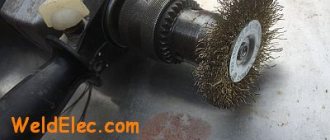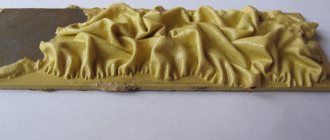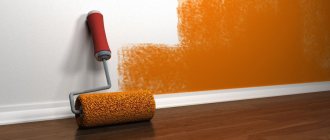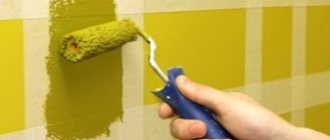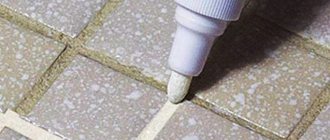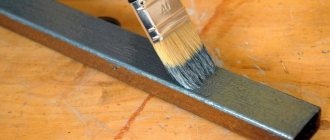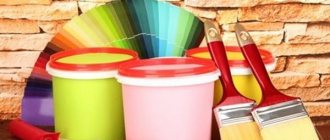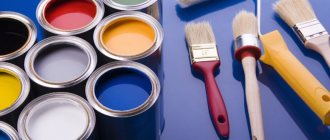There are many ways to remove paint from walls. They differ in speed of execution, require certain knowledge and compliance with safety standards.
By making the right choice, you can significantly facilitate repair work and speed up its implementation.
In this article, we will look at all the known ways to remove paint from walls yourself.
Solvents and removers
You can remove paint using special solutions. They are sold in hardware stores.
The products must be used according to the instructions:
- Remove dust and dirt from the wall.
- Apply the composition to its surface.
- Leave for effect.
- Clean off the paint with a spatula.
The holding time of the composition differs, depending on the aggressiveness of its components.
Top 3 best products
The best products for removing paint from walls:
Gel Owatrol Marine D1 .
This is a powerful water-based solvent that is suitable for removing any paint. You can get rid of 8 layers of coating at one time. The gel has a thick consistency. It is applied to the wall in a thick layer and left until the paint is completely dissolved. All you have to do is remove it with a brush and water. The cost of 1 liter of product is 1320 rubles.- Solvent 646 . Moisten a roller or brush with the liquid, apply it to the wall, leave for 3-5 minutes, after which the softened paint is removed with a spatula. The cost of 1 liter is 200 rubles.
- Antikras wash . The product contains solvents that allow you to get rid of even old coatings. The liquid is applied to the wall in an even layer, left for 3-15 minutes, after which the paint is removed with a spatula. The cost of 1 kg of remover is 400 rubles. For 1 sq. m. it takes about 0.15 kg of product.
When using any paint remover, the area must be thoroughly ventilated.
Homemade composition
To prepare the wash yourself, you will need the following components:
- 2 parts ammonia.
- 1 part turpentine.
The resulting composition is applied to the wall and left for 20 minutes. When the coating begins to swell and fall off, it is removed with a spatula. Since the product has a pungent odor, you need to wear a respirator when working.
Video
Accessories and consumables for tools
The figure shows which diamond cups and cutting heads are suitable for tools (list by article number below):
- Diamond cups for Festool RENOFIX RG 130 E grinder
- Tool heads, disc cutters, grinding wheels for the Festool RENOFIX RG 80 E deburring router
- Cutting heads, disc cutters, grinding wheels for the Festool RENOFIX RG 150 E deburring router
- Further accessories for Festool RENOFIX RG 130 E and RG 150 E tools
Diamond cups
for the Festool RENOFIX RG 130 E grinder with a diameter of 130 mm, internal diameter 25/22.2 mm (follow the link to the product page with availability and price):
1. DIA HARD-D130 PREMIUM Diamond Cup for old hard concrete, epoxy coatings on solid substrates, coatings and paints on concrete surfaces
- 768017 Diamond cup FESTOOL DIA HARD-D130 PREMIUM
2. Diamond cup DIA ABRASIVE-D130 PREMIUM for materials with a high sand content, screed floors, fresh concrete, adhesive on screed floors, sand-lime bricks and porous concrete
- 768018 Diamond cup FESTOOL DIA ABRASIVE-D130 PREMIUM
- We recommend
(a cup is included in this kit) Special promotion FESTOOL RG 130 ABR /CTM – kit for removing materials containing sand, such as screeds, valid. until 31-12-2014
3. Diamond cup DIA STONE-D130 PREMIUM for very hard materials and hard concrete (harder than B 35)
- 769166 Diamond cup FESTOOL DIA STONE-D130 PREMIUM
4. Diamond cup DIA THERMO-D130 PREMIUM for thermoelastic materials on concrete, seamless floors, etc.
- 768023 Diamond cup FESTOOL DIA THERMO-D130 PREMIUM
5. Diamond cup DIA UNI-D130 PREMIUM for removing paint and glue on wooden substrates
- 769167 Diamond cup FESTOOL DIA UNI-D130 PREMIUM
Tool heads, disc cutters, grinding wheels
for the Festool RENOFIX RG 80 E stripping router (follow the link to the product page with availability and price): 6. Cutting head SZ-RG 80 = 12 “Form Spitz” carbide disc cutters for hard plaster, adhesive residues and plaster based on synthetic resins
- 767982 Tool head FESTOOL SZ-RG 80
Disc cutters HW-SZ 12 = Disc cutters for SZ-RG 80, complete set including spacers and clamping elements
- 769132 Straight disc cutters FESTOOL, set of 12 pcs. HW-SZ 12
7. Cutting head FZ-RG 80 = 12 carbide disc cutters “Form Flach” for soft plaster and fresh concrete, adhesive residues and protective coatings
- Bestseller
769131 Tool head FESTOOL FZ-RG 80
Disc cutters HW-FZ 12 = Disc cutters for FZ-RG 80, complete set including spacers and clamping elements
- 769133 FESTOOL helical disc cutters, set of 12 pcs. HW-FZ 12
8. DIA HARD-RG 80 cutting head with diamond cup for hard materials, for old hard concrete, epoxy coatings on solid substrates, coatings and paints on concrete surfaces
- 767983 Cutting head with diamond cup for concrete FESTOOL DIA HARD-RG 80
Diamond cup DIA HARD-D80 diamond cup for tool head DIA HARD-RG 80
- 769054 Diamond cup for concrete FESTOO DIA HARD-D80
9. Cutting head DIA ABRASIVE-RG 80 with a diamond wheel for abrasive materials, for materials with a high content of sand, self-leveling floors, fresh concrete, adhesive on self-leveling floors, sand-lime bricks and porous concrete
- 767984 Cutting head with diamond cup for sandstone FESTOOL DIA ABRASIVE – RG 80
Diamond wheel DIA ABRASIVE-D80 diamond cup for tool head DIA ABRASIVE-RG 80
- 769055 Diamond cup for sandstone FESTOOL DIA ABRASIVE-D80
10. Cutting head DIA THERMO-RG 80 with Thermo diamond cup, for thermoelastic materials on concrete, self-leveling floors, etc.
- 769082 Cutting head with diamond cup for thermoelastic materials on concrete FESTOOL DIA THERMO-RG 80
Diamond cup DIA-THERMO 80 diamond cup for head DIA THERMO-RG 80
- 769084 Diamond cup for thermoelastic materials on concrete FESTOOL DIA THERMO-D80
11. DIA UNI-RG D80 cutting head with universal diamond cup for removing paint and glue on wooden substrates
- 769169 Cutting head with diamond cup FESTOOL DIA-UNI-RG 80
Diamond cup DIA UNI-D80 diamond cup for tool head DIA UNI-RG 80
- 769170 Diamond cup FESTOOL DIA UNI-D80
12. Cutting head HW COARSE-RG 80 with carbide cup for rough cutting, for elastic coatings, adhesive on soft plastered surfaces and lime on beams, thick layers of paint and old paintwork, roughening fiberglass
- 769056 Tool head dir. from cups with soldering from TV alloy, rough FESTOOL HW COARSE-RG 80
Carbide cup HW COARSE-D80 diamond cup for cutting head HW COARSE-RG 80 769058 Cup with soldering FESTOOL HW COARSE-D80 13. Cutting head HW FINE-RG 80 with carbide cup for fine processing, for elastic coatings, adhesive on soft plastered surfaces and lime on beams, thick layers of paint and old paint coatings, roughening fiberglass
- 769057 Head dir. from cups with soldering from TV alloy, thin FESTOOL HW FINE-RG 80
Carbide cup HW FINE-D80 diamond cup for cutting head HW FINE-RG 80
- 769059 Cup with soldering FESTOOL HW FINE-D80
Cutting heads, disc cutters, grinding wheels
for the Festool RENOFIX RG 150 E stripping router (follow the link to the product page with availability and price): 14. Cutting head SZ-RG 150 = 35 “Form Spitz” carbide disc cutters for hard plaster, adhesive residues and plaster based on synthetic resins
- 768020 Cutting head with straight teeth. cutters, set FESTOOL SZ-RG 150
Disc cutters HW-SZ 35 disc cutters for SZ-RG 150, complete set, including bushings
- 769050 Straight disc cutters FESTOOL HW - SZ 35 set of 35 pcs.
15. Cutting head FZ-RG 150 = 35 carbide disc cutters “Form Flach” for soft plaster and fresh concrete, adhesive residues and protective coatings
- 769105 Cutting head with helical tooth. cutters, set FESTOOL FZ-RG 150
Disc cutters HW-FZ 35 disc cutters for FZ-RG 150, complete set, including bushings
- 769051 Helical disc cutters FESTOOL HW-FZ 35 set of 35 pcs.
16. DIA HARD-RG 150 cutting head with diamond inclusions for hard materials, for old hard concrete, epoxy coatings on solid substrates, coatings and paints on concrete surfaces
- 768021 Cutting head with diamond cup, for concrete FESTOOL DIA HARD-RG 150
Diamond cup DIA HARD-D150 diamond cup for tool head DIA HARD-RG 150
- 769069 Diamond cup for concrete FESTOOL DIA HARD-D150
17. Cutting head DIA ABRASIVE-RG 150 with diamond inclusions for abrasive materials, for materials with a high content of sand, self-leveling floors, fresh concrete, adhesive on seamless floors, sand-lime bricks and porous concrete
- 768022 Cutting head with diamond cup for sandstone FESTOOL DIA ABRASIVE – RG 150
Diamond cup DIA ABRASIVE-D150 diamond cup for tool head DIA ABRASIVE-RG 150
- 769070 Diamond cup for sandstone FESTOOL DIA ABRASIVE-D150
18. Tool head DIA THERMO-RG 150 with Thermo diamond cup, for thermoelastic materials on concrete, screeds, etc.
- 769083 Cutting head with diamond cup for thermoelastic materials on concrete FESTOOL DIA THERMO-RG 150
Diamond cup DIA-THERMO-D150 diamond cup for cutting head DIA THERMO-RG 150
- 769085 Diamond cup for thermoelastic materials on concrete FESTOOL DIA THERMO-D150
19. Cutting head DIA UNI-RG 150 with universal diamond cup for removing paint and glue on wooden substrates
- 769120 Cutting head with diamond cup FESTOOL DIA-UNI-RG 150
Diamond cup DIA UNI-D150 diamond cup for cutting head DIA UNI-RG 150
- 769122 Diamond cup FESTOOL DIA UNI-D150
Other equipment
for Festool RENOFIX RG 130 E and RG 150 E tools (follow the link to the product page with availability and price):
769080 Depth gauge FESTOOL GT-RG 130 769110 Brush insert FESTOOL BC-RG 130 Recommended
769109 Guide rod FESTOOL BG-RG 150 769121 Balancer FESTOOL BR-RG 150 769123 Brush insert FESTOOL BC-RG 150
Which method is better to choose and why?
In each specific situation it is better to resort to a certain method, namely:
The safest way to remove oil paint is mechanically.
Its heat treatment can lead to fire if the wall surface is heated for too long. Professional repairmen do not recommend using a blowtorch or iron at all. If the choice nevertheless fell on heat treatment of the walls, then you need to stop at a construction hair dryer.- Chemical methods for removing old coating are considered effective, but you need to choose professional products. It is recommended to use them in well-ventilated areas and strictly according to the instructions.
- It is most convenient to clean water-based paint using newspapers. To do this, they are glued to the wall. When the composition dries, the paper is simply torn off with sharp movements. The coloring composition will come off along with it.
- When processing large areas, it is most rational to use electric tools: a drill with a chain or a grinder. Otherwise, the paint cleaning process will take several weeks.
- Corners and other hard-to-reach places are worked out with a spatula or chisel. You can also use solvents.
The right combination of several methods will allow you to deal with paint on the walls quickly and safely.
Mechanical method
To remove the old coating from the surface of the walls, you can do it manually or using various electric tools - grinders, drills, sanders. In this case, it is necessary to take into account the type of surface, as well as whether the work is carried out in a room where people live, or whether it is empty and completely given over for renovation.
In the first case, you want to carry out the work with a minimum of dirt and dust, which means you will have to abandon electrical assistants.
Mechanical methods of paint removal
Working with an electric sander
Working with an angle grinder is the fastest and most risky method of dismantling old paint. All you need to do is install a special removable attachment into the device and turn on the device by pressing a button. It is advisable to work smoothly, easily, performing circular movements.
Be sure to protect your eyes with glasses, as during the process a large amount of dust appears and pieces of old paint fly around.
If you need to remove large deposits, it is recommended to use an attachment with a chain, which, when rotated, will knock out whole pieces of dried material. But it is not recommended for use on hard concrete foundations.
The grinding wheel is a universal solution that can be tried on any surface. It is used in different rooms - bathroom, living room, hall. Using a sanding machine you can efficiently, easily and quickly remove old material from walls without damaging them.
Working with an electric drill
This tool is needed when the base is concrete. The best adhesion is created between such a coating and oil paint, which is not so easy to break and remove the used material.
Of great importance is the fact who laid the coating - a professional or an amateur. Removing old paint after a specialist is much more difficult than after an amateur. If work is carried out in an apartment building, it is not recommended to use chemical solvents so that the smell does not spread throughout the entire entrance and cause harm to neighbors.
In this case, you need to use an electric drill. This is the optimal solution both in terms of speed and security. It is also recommended to work in protective equipment and shoes, a mask, a hat, and glasses.
It is better to operate the device at low frequencies in order to maximize control over the process. To remove the old coating, only touch the wall with the edge of the nozzle, without moving too quickly or too deeply.
If the paint comes off easily, you can use a metal brush. In severe cases, it is recommended to resort to an attachment, which is a chain-linked link equipped with a washer.
Working with a chisel and hammer
A chisel is the first device that everyone starts working with when trying to remove old decor from smooth walls. It is especially convenient to use it in cavities and narrow places, as well as in areas where neatness is required - in the area of sockets, decorative elements, switches, cables.
This carpentry tool will help out when you need to remove old paint from wood. But it quickly becomes dull and its capabilities are not always sufficient to dismantle obsolete material, although this is one of the most economical and safest methods that does not require investment.
In areas where such a tool is already powerless, it is worth using a chisel. It does not bend under mechanical stress. By tapping the handle with a hammer, you can remove even the most difficult coating from the walls.
Ax work
This may not seem like the right tool for removing old paint, but it is very effective. The master's task is to make notches on the paint. The blows must be applied tangentially to the wall, trying not to go too deep into it. It is good if the distance between the notches does not exceed 10 mm.
As the cuts are made, it is necessary to moisten the surface with water. It should be absorbed deep into the material. After this, the paint can be easily removed with the same tool, bringing it almost parallel to the wall covering.
This ability is not convenient for everyone. Even a light ax is not easy to swing, especially when the repairs are carried out by women. In addition, a lot of notches need to be made, and the master’s hands will get tired in any case. Therefore, you need to resort to it only in special, difficult-to-reach places on the walls.
Do-it-yourself removal of different types of paint
There are recommendations for removing different types of paint. The choice of cleaning composition depends on this.
| Paint type | Preferred cleaning method |
| Oily | Mechanical or chemical cleaning method. |
| Acrylic | Solvents containing acetone or alcohols, mechanical cleaning. |
| Water-based | Mechanical method: with a grater or sandpaper. With a professional remover, or glue and newspaper. |
| Obsolete | It is best to combine several methods: large areas are treated with power tools, and hard-to-reach areas are treated with a remover or solvent. |
Cleaning different types of surfaces
Depending on the base of the surface on which the coloring composition is applied, the methods for removing it will differ.
| Wall type | Cleaning Features |
| Brick | You can use a drill with attachments. |
| Concrete | It is recommended to remove paint mechanically: with a spatula, an ax or a chisel. |
| Cement | It is faster and safer to remove paint from a cement wall using a sander. Such surfaces are not afraid of mechanical cleaning. |
| Plastered | It is not recommended to clean plastered walls using mechanical methods. It is better to use specialized chemistry. |
| Wooden | Wood is a soft species that can be easily damaged. It is unacceptable to handle it with chemicals or rough tools such as an ax. The best option is to use a chisel and hammer. This will increase the accuracy of the work and will not damage the wall. |
How to delete?
There are many methods for removing old paint from a wall, from the old “grandfather’s” to the newfangled ones, using the latest materials and tools. When using chemicals to remove old coating, apply the chemical to the wall using brushes or rollers, starting from the top edge. It is necessary to apply thickly and evenly, it is advisable to do it quickly. For a multi-layer coating, you will have to apply the product more than once. After a certain time (specified in the instructions for use), armed with a scraper or chisel, you need to start scraping off the peeling layer of paint from the bottom of the wall. Having treated the entire wall in this way and going over the top with a metal brush, we wash it with a soda solution at room temperature.
It is necessary to apply ordinary water to the wall and wait until the plaster absorbs it. Then, using rhythmic forward movements, make one notch over the other. The smaller the distance between them, the better the paint comes off. It is better to take a small and sharp ax, as it will be much easier to work with. Burning is done using a gas burner. One person heats the wall to the point where it begins to darken. At this time, his assistant immediately cleans the darkened area with a scraper with a long handle or a special spatula.
This is a good and fast, but unsafe method. This clearing must be done with caution.
The grinder and hammer drill require special attachments that help in the work. They are attached to the tool and, when working, perfectly remove paint and plaster from the walls. You can also use a variety of wire brushes. Even a child can work with a spatula and chisel. Using this tool, you need to pick out the old paint from the wall with slight pressure at an angle.
When using a construction hair dryer, the surface is methodically treated with hot air and immediately cleaned with a chisel. Then the surface must be thoroughly washed with warm soapy water and cleaned with a cloth.
This way you can get rid of the white.
How to clean walls from old water-based paint
Unlike classic compositions, water-based emulsion can be removed using improvised materials. To remove it, use plain water or you can prepare a soap solution.
In order to wash off water-based paint faster, numerous scratches and notches are made on the surface of the wall.
Process algorithm:
- The prepared composition is applied to the surface; it must be well soaked with liquid.
- After 10 minutes, the procedure is repeated.
- Direct removal. The coating is washed with a sponge and the water is changed periodically. Difficult areas should be removed with a scraper or spatula.
The method is quite labor-intensive and dirty, but more environmentally friendly and eliminates the possibility of damage to the walls.
How to make your own wash
Prepared home remedies are effective and less expensive:
- Mix turpentine and ammonia in a ratio of 1:2. To apply the liquid, use a brush or roller. Wait 1 hour, then clean the surface with a spatula, wash it and dry it.
- Mix chalk with lime paste (in a 1:1 ratio), add a little 20% caustic soda solution. The resulting mixture is applied in a 2 mm layer to the treated area. After 1-1.5 hours, remove the paint layer by any mechanical method.
- Add a 5% iodine solution (100 ml) to water (5 l). The solution is stirred well and applied to the surface. After cracks appear, remove the coating with a spatula.
Latex paintwork materials can be washed off with a solution containing chloroform and dichloroethane; acrylic paintwork materials can be washed off with products containing salicylic acid.
Preparation for wallpaper
In order for the wallpaper to stick well, the layer on which it is attached must be stronger and heavier than it . If they weigh more, they will very soon simply move away from the wall. Therefore, all cracked paint must be cleaned off. Defects must be puttied.
You can check whether the wallpaper will be securely fixed in a simple way: apply glue to the wall and leave until completely dry. If it is securely fixed and does not come off in the form of a film, then you can start gluing.
Oil and alkyd paints are sanded with sandpaper. The formed depressions will improve the adhesion of the glue to the surface.
Before covering a wall with wallpaper, you need to remove dust and other contaminants from it, and then prime it . They will adhere firmly to such a surface, even if all the coloring composition is not cleaned off.
You should not glue light wallpaper to walls painted with dark paint. It will show through them in ugly spots.
Do I need to remove old paint?
If during renovation a wall with old paint is covered with plasterboard, then there is no need to waste time dealing with the residue.
But if the plans include treating this particular surface, then the previous coating will have to be removed. Otherwise, the tile will not stick (and even if it does, it will fall off very quickly), and the wallpaper will come off as soon as the glue dries. It is generally impossible to predict how the new paint will behave on the old one.
Did you know? The word "repair" comes from France. It was originally used in the army to mean “to change an old horse to a young one.”
- what kind of paint is on the wall now, how many layers;
- what type of surface we are dealing with;
- what tools are available;
- event budget.
Most often, it is the first point that causes difficulties. The paint can be acrylic, water-based or oil-based. Even if an experienced craftsman can determine the type of paint by eye, it is not possible to guess the layers. Therefore, it is recommended to select a small area of the wall for experiments, so that you can determine the most effective cleaning method in practice.
The type of surface is usually easy to distinguish even for a novice craftsman: wood, metal or concrete. The most difficult combination to remove is oil paint and concrete.
Let's take a closer look at the instrument.
Find out how to build a cellar with ventilation, a sheepfold, a chicken coop with ventilation, a veranda, a gazebo, a barbecue, a fence with your own hands.
The most common mistakes
When performing work, inexperienced repairmen make the following mistakes:
To remove paint from large areas, only manual labor is used, for example, using a spatula. This takes a lot of time and effort. It is better to give preference to power tools.- Remove paint using a solvent in rooms with poor ventilation. Inhalation of toxic fumes can cause poisoning.
- Overheat the walls using a hair dryer or blowtorch. Such carelessness may cause a fire.
- Working too hard on the wall with an ax or similar tool. It will be difficult to cope with the emerging irregularities.
You cannot work without gloves, regardless of the chosen paint removal method.
Important Tips
Tips to take into account:
- If the paint has peeled off and cracked, then its dismantling is mandatory. Walls on which the coating fits tightly and cannot be cleaned mechanically can be left untouched.
- You can warm up the wall only in places where there are no wires or sockets.
- Personal protective equipment should always be used.
- When working with heating appliances, you should take care of your own safety and have fire extinguishing agents on hand.
When using methods that lead to the formation of a large amount of dust, a damp cloth should be placed at the threshold of the room. This will prevent it from spreading throughout the apartment.
Help from professionals
If you don’t want to remove the paint from the walls yourself, you can turn to specialists for help. The cost of work is determined by its volume. For each square meter you will have to pay at least 100 rubles .
You can find professional repairmen through advertisements in newspapers, on the Internet or on TV.
Preference should be given to those teams that have their own office. The longer the company operates, the better. Positive reviews are welcome .
To check them, you can try to contact the people who left them. The speed of work depends on the area of the room. A standard kitchen or bathroom takes no more than 2-3 days.
You can find out more about how to remove paint from kitchen walls yourself here, and from bathroom walls here.
